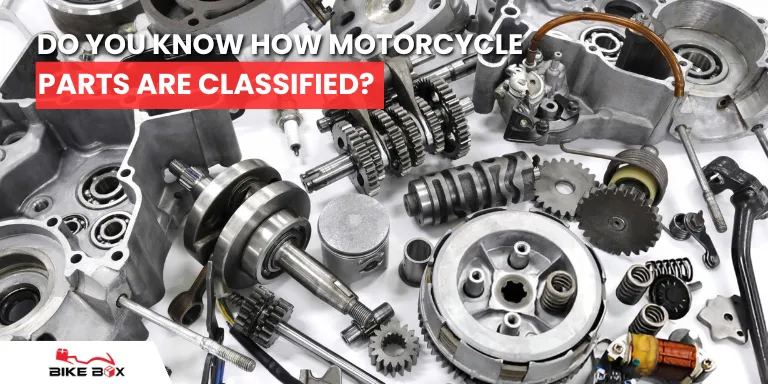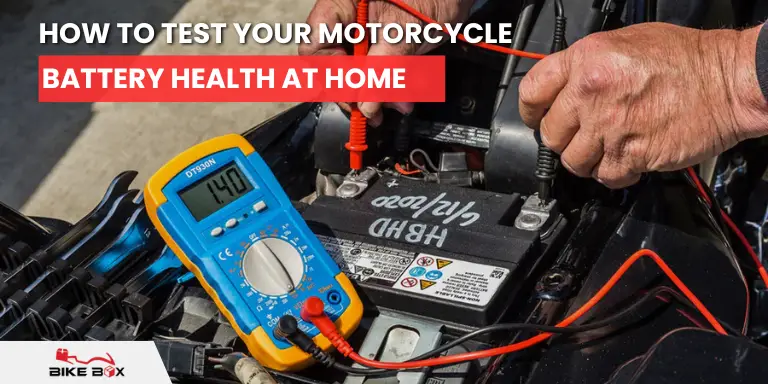Motorcycle maintenance is an important aspect of vehicle ownership. Motorcycles are widely used for personal transport and delivery services. When a motorbike is broke, you run to a mechanic and ask to repair it with original spare parts. Yet, many motorcycle owners are unfamiliar with how the parts on their motorcycles are classified and which spareparts should be replaced in case of a problem happened with the motorbike. According to industry data, over 60% of global motorcycle owners are unaware of the technical classifications of their vehicle’s spare parts, despite parts replacement accounting for approximately 30% of a bike’s lifetime maintenance expenses. Understanding how motorcycle parts are categorized can directly impact your maintenance decisions, operational costs, safety, and the resale value of your motorcycle.
Summary:
This article highlights why understanding motorcycle spare parts classification matters, especially in the UAE where maintenance costs make up 30% of a bike’s lifetime expenses. It explains two main classification types: technical function (engine, transmission, walking system, control system, electrical parts) and market source (OEM, Aftermarket, Performance Grade). The article covers how this impacts safety, costs, and resale value, with a UAE-specific demand breakdown showing 65% parts use in commuter bikes. It also explains how local mechanics classify parts by origin and price. BikeBox is featured as a reliable UAE supplier offering original, OEM, ODM parts, and expert repair services. The article encourages riders to check part categories during repairs to avoid safety risks and overspending.
The Classification of Motorcycle Spare Parts
The classification of motorcycle parts is important for several reasons:
- Standardization: The classification of spare parts brings uniformity in specifications, measurements, and performance across brands and models.
- Regulatory Compliance: UAE road and vehicle regulations mandate the use of certified, compatible parts for roadworthiness and risk of accidents due to sudden vehicle breakdowns.
- Compatibility Checks: Proper classification helps mechanics and suppliers select the right spare parts for different motorcycles.
- Consumer Protection: Prevents counterfeit or substandard motorbike spare parts from being sold as genuine, safeguarding buyers against potential safety hazards.
A standard commuter motorcycle typically consists of over 130 individual parts. The complexity increases with high-performance, cruiser, or adventure motorcycles.
| Bike Type | Average Number of Parts |
| Commuter | 130+ |
| Cruiser | 180+ |
| Sports | 200+ |
| Adventure | 220+ |
The table above clearly mentions bike types and average spare parts inclusion accordingly
Major Motorcycle Parts Categories
The spare parts for motorcycles are generally classified into the following key categories:
-
Engine Parts
These include the primary components responsible for the motorcycle’s power generation. These include:
- Cylinder
- Piston
- Crankshaft
Engine parts represent 40–50% of a motorcycle’s total value due to their importance and complexity.
-
Body Parts
This category covers the exterior elements of the motorcycle that impact structure and appearance:
- Fuel tank
- Mudguards
- Side panels
- Fairings
Body parts affect both the aerodynamics and resale value of a motorcycle in the used bike market.
-
Electrical Parts
Electrical parts include components that manage power distribution and control systems consisting of:
- Battery
- Wiring harness
- CDI (Capacitor Discharge Ignition) unit
Market Trend: Lithium-ion batteries have gained an 18% year-on-year increase in market share due to their superior performance in high-temperature environments like the UAE.
-
Transmission Parts
These are responsible for transferring power from the engine to the wheels:
- Chain
- Sprocket
- Gearbox
More than 70% of chain and sprocket wear occurs because of improper lubrication, not necessarily poor material quality.
-
Safety & Suspension Parts
These components directly impact the ride quality and safety:
- Disc brakes
- Shock absorbers
- Handle grips
Correctly tuned front suspension systems can improve overall bike riding comfort by up to 30%.
-
Accessories & Custom Parts
These are non-essential but performance-enhancing or decorative parts and include:
- Bluetooth helmets
- LED indicators
- Crash guards
Understanding these categories can significantly impact your decisions when selecting parts. To learn more about the classification of parts by function and market source, and how to choose the right one for your bike, don’t miss our Guide to Choose Motorcycle Spare Parts, which provides in-depth insights into this process.
How Motorcycle Parts Are Classified by Function vs. Market Source?
Before discussing OEM, Aftermarket, and Performance parts, it’s important to understand that there are two distinct classification systems used in the motorcycle spare parts industry:
1. Technical/Functional Classification
This is based on the spare part’s role within the vehicle system, for example:
- Engine and Accessories
- Transmission System Parts
- Walking System Parts
- Control System Parts
- Electrical and Instrument Parts
This system ensures mechanical compatibility, operational safety, and regulatory compliance.
2. Market-Based / Source Classification
This refers to how parts are categorized based on their manufacturing source, quality standards, and application purpose, regardless of their technical category.
| Type | Definition |
| OEM (Original Equipment Manufacturer) | Spare Parts made by the same supplier that produces components for the motorcycle brand’s factory assembly. |
| Aftermarket | Spare parts produced by independent third-party manufacturers not officially affiliated with the bike brand. |
| Performance Grade | Specialized, high-performance parts to exceed standard specifications for racing, touring, or customized usage. |
Note:
A spare part belonging to any functional category, for example, a clutch plate (from Transmission System Parts) can be classified as OEM, Aftermarket, or Performance Grade based on its production source and application.
This distinction is widely practiced in the UAE spare parts market, where both classification systems operate side-by-side for pricing, warranty, and compatibility considerations.
OEM vs Aftermarket vs Performance Spare Parts
OEM (Original Equipment Manufacturer)
These are the spare parts produced by the original motorcycle manufacturer or an officially authorized supplier.
Advantages:
- Perfect fit
- Certified quality
- Maintains warranty coverage
Disadvantages:
- Higher cost
| Part | OEM Price (AED) | Aftermarket Price (AED) |
| Clutch Plate | 450 | 250 |
| Brake Pads | 300 | 120 |
| Chain Sprocket | 600 | 320 |
Aftermarket Spare Parts
Manufactured by third-party suppliers not officially affiliated with the motorcycle brand.
Advantages:
- Widely available
- Lower price
Disadvantages:
- Variable quality
- May affect warranty
- Requires careful selection
Performance Grade Spare Parts
Specialized, high-performance parts designed for racing or touring applications.
Advantages:
- Enhanced performance
- Customization options
Disadvantages:
- Typically voids manufacturer warranties
- May require additional modifications
Global Insight: The demand for carbon-fibre motorcycle parts has increased by 23% worldwide over the last two years, with availability expanding in UAE free trade zones.
UAE Market-Specific Spare Parts Demand
Based on market observations within the United Arab Emirates:
- 65% demand for commuter motorcycle parts
- 25% for sports and customized motorcycles
- 10% for cruisers and adventure bikes
Custom body modifications, upgraded lighting systems, and aftermarket exhaust systems remain common in regions like Al Quoz, Deira, and Sharjah Industrial Area.
How Mechanics Classify Motorcycle Spare Parts in Practice?
While official catalogs use technical classifications, mechanics in the UAE often categorize spare parts based on origin and quality:
- Original Japanese: High-grade OEM or imported parts
- Taiwan-made: Quality aftermarket components
- Local stock: UAE-sourced aftermarket or used parts
- China-made: Lower-cost aftermarket options
This practical classification assists mechanics in offering options to customers based on price and quality requirements.
How This Classification Knowledge Helps Save Repair/ Replacement Costs?
Classification knowledge of spare parts helps you over-spending or multipe times replacement. Because if not so, the fake spare part selection can result in:
- Premature wear and failure
- Higher fuel consumption
- Reduced ride safety
- Increased repair costs
Guideline for Spare Parts Selection:
- Use OEM parts for engine, brakes, and suspension
- Choose Aftermarket for cosmetic or non-critical components
- Install Performance Grade only with full system compatibility checks
If you’re wondering how the quality of spare parts affects the safety and performance of your motorcycle, take a look at our article on Why Quality Motorbike Spare Parts Matter for Safety. This guide provides further insights into how choosing the right components can protect both your bike and your safety.
Future Trends in Motorcycle Parts
The motorcycle parts industry in the UAE is shifting toward:
- Smart, IoT-enabled components for real-time performance monitoring
- Electric motorcycle components, driven by demand in delivery fleets
- Environmentally sustainable materials, with recycled plastics projected to account for 20% of total parts by 2026
Reliable Sourcing and Expert Repairs with BikeBox
Both quality and compatibility of spare parts directly affect motorcycle performance and operational safety, choosing the right supplier is important. BikeBox stands out in the UAE’s motorcycle aftermarket by providing a wide selection of original spare parts for motorcycles, including both opOEM (Original Equipment Manufacturer) and ODM (Original Design Manufacturer)tions.
Every spare part supplied by BikeBox is accurately classified by both technical function and production origin, ensuring that customers — whether workshop managers, delivery operators, or private riders — receive spare parts that match manufacturer standards and UAE regulations.
In addition to spare parts supply, BikeBox offers expert repair and maintenance services for motorcycles across the UAE. From routine replacements to advanced mechanical repairs, the spare parts replacement and repairs is made by expert technicians and mechanics in the UAE, contributing to safer, longer-lasting vehicle performance in the UAE.
Conclusion
Motorcycle spare parts classification knowledge is important for responsible ownership and operational efficiency of motorbikes. In the UAE, high temperatures, heavy delivery business, and rapid urban development influence vehicle maintenance practices, understanding part types and their appropriate applications offers clear benefits in terms of safety, durability, and cost management.
Motorcycle owners are encouraged to inquire about spare part categories during repairs and servicing and make sure that installed components are suitable for their specific vehicle make and usage conditions.
FAQ
What is the difference between OEM and genuine parts?
OEM parts are produced by the original supplier for the motorcycle brand, while genuine parts are branded versions of OEM components sold by the manufacturer.
Is it safe to use aftermarket motorcycle parts?
Yes, for non-critical components. Use certified parts for engines, brakes, and safety systems.
Why do performance parts void warranties?
Because they exceed the manufacturer’s design parameters and can affect the integrity of connected components.
How can counterfeit parts be identified?
Counterfeit spare parts can be identified by the absence of official labeling or QR codes, inconsistent packaging colors, unusually low pricing, missing Arabic-language safety labels in compliance with UAE regulations




